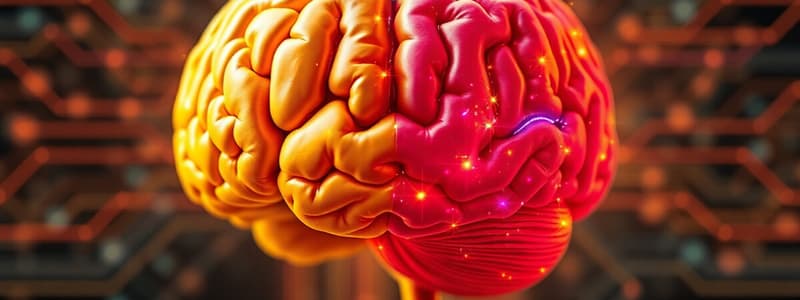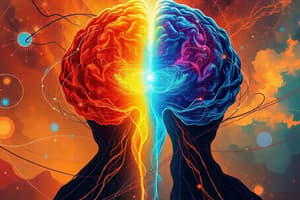Podcast
Questions and Answers
What is the primary focus of the material provided?
What is the primary focus of the material provided?
- Historical events and their impact
- Visual patterns and structures (correct)
- Analytical methods for interpretation
- Technical data representation
Which aspect is least likely to be addressed in the content?
Which aspect is least likely to be addressed in the content?
- Mathematical equations (correct)
- Color theory and its applications
- Comparative analysis of different formats
- Aesthetic qualities of visuals
How can the structures presented in the material be characterized?
How can the structures presented in the material be characterized?
- Complex and multifaceted (correct)
- Simple and linear
- Symmetrical and balanced
- Chaotic and disorganized
Which of the following would likely enhance understanding of the visual elements?
Which of the following would likely enhance understanding of the visual elements?
What type of analysis is most relevant to interpreting the content?
What type of analysis is most relevant to interpreting the content?
What element is likely secondary in importance when analyzing the material?
What element is likely secondary in importance when analyzing the material?
Which approach would be least effective for expressing ideas related to the content?
Which approach would be least effective for expressing ideas related to the content?
What is the most critical factor in understanding the material's visual compositions?
What is the most critical factor in understanding the material's visual compositions?
What can be inferred about the overall structure of the content provided?
What can be inferred about the overall structure of the content provided?
Which of the following is a potential reason for the lack of coherent text in the content?
Which of the following is a potential reason for the lack of coherent text in the content?
How might someone evaluate the clarity of ideas in the provided content?
How might someone evaluate the clarity of ideas in the provided content?
What would likely be a challenge for a reader attempting to find information in this content?
What would likely be a challenge for a reader attempting to find information in this content?
What could be a potential outcome if this content is presented in a formal setting?
What could be a potential outcome if this content is presented in a formal setting?
What is the best approach to analyze content similar to what is provided?
What is the best approach to analyze content similar to what is provided?
If someone were to present this content in an academic environment, what adjustments might be necessary?
If someone were to present this content in an academic environment, what adjustments might be necessary?
Which interpretation could be misleading when viewing this content?
Which interpretation could be misleading when viewing this content?
What is the most likely outcome of excessive pressure on materials?
What is the most likely outcome of excessive pressure on materials?
Which property is often affected when a material undergoes thermal expansion?
Which property is often affected when a material undergoes thermal expansion?
What occurs during the phase transition of a material?
What occurs during the phase transition of a material?
How does moisture typically affect materials?
How does moisture typically affect materials?
What characteristic is crucial for the fatigue resistance of a material?
What characteristic is crucial for the fatigue resistance of a material?
Which of the following is least likely to affect the hardness of a material?
Which of the following is least likely to affect the hardness of a material?
Which factor is essential in determining the ductility of a material?
Which factor is essential in determining the ductility of a material?
What effect does alloying typically have on materials?
What effect does alloying typically have on materials?
What is the fundamental difference between quantitative and qualitative research?
What is the fundamental difference between quantitative and qualitative research?
Which of the following best describes a case study?
Which of the following best describes a case study?
What role does sampling play in research?
What role does sampling play in research?
Which of the following statements about reliability and validity is true?
Which of the following statements about reliability and validity is true?
In research methodology, what is the purpose of a literature review?
In research methodology, what is the purpose of a literature review?
Which research method is often used to gather rich, qualitative data through direct interaction?
Which research method is often used to gather rich, qualitative data through direct interaction?
What is thematic analysis primarily used for in qualitative research?
What is thematic analysis primarily used for in qualitative research?
What distinguishes a longitudinal study from a cross-sectional study?
What distinguishes a longitudinal study from a cross-sectional study?
What is the primary theme conveyed in the given content?
What is the primary theme conveyed in the given content?
Which approach would most effectively address the difficulties presented in the content?
Which approach would most effectively address the difficulties presented in the content?
What misconception might a student have regarding the content's complexity?
What misconception might a student have regarding the content's complexity?
Which of the following aspects is less likely to aid in overcoming the challenges described in the content?
Which of the following aspects is less likely to aid in overcoming the challenges described in the content?
What factor would contribute the most to simplifying abstract concepts?
What factor would contribute the most to simplifying abstract concepts?
Which instructional strategy might hinder the understanding of complex material?
Which instructional strategy might hinder the understanding of complex material?
Which statement accurately reflects a benefit of embracing complexity in learning?
Which statement accurately reflects a benefit of embracing complexity in learning?
What is a common barrier students face when engaging with complex content?
What is a common barrier students face when engaging with complex content?
Flashcards are hidden until you start studying
Study Notes
Key Ideas
- The text discusses the concept of a "second brain" and how our external environments and belongings can hold valuable information and thoughts.
- It emphasizes the importance of being mindful about how we organize and interact with our external environments.
- The text also highlights the idea that our external environment can act as an extension of our minds, allowing us to offload information and access it later.
- The text suggests that by organizing our external world, we can create a more efficient and accessible "second brain."
The Second Brain
- Our external world holds information, thoughts, and memories that can assist us in various ways.
- Objects and environments can act as a "second brain," augmenting our own memory and cognitive abilities.
Organizing the Second Brain
- By carefully organizing our physical environments, we can create a system that allows for easy access and retrieval of information.
- This system can include physical objects, digital files, and even notes written in a particular format.
Benefits of a Second Brain
- A well-organized "second brain" allows us to offload information, freeing up mental processing power.
- It provides a platform for collaboration and sharing of ideas.
- It encourages us to be more thoughtful about our external world and how we interact with it.
Practical Applications
- The "second brain" concept can be applied in various areas of life, from personal organization to professional pursuits.
- It encourages a more mindful and deliberate approach to information gathering and processing.
- By organizing our external environments effectively, we can create a system that supports our cognitive functions and improves our overall productivity.
Studying That Suits You
Use AI to generate personalized quizzes and flashcards to suit your learning preferences.




